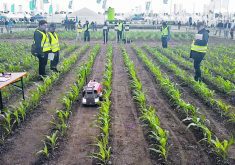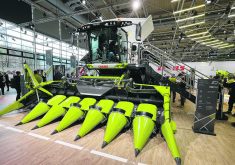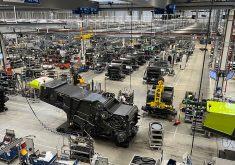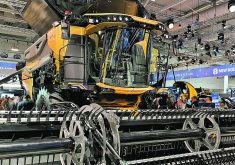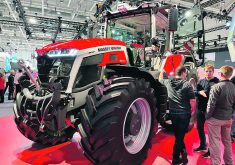The JCB Fastrac 4000 series may interest producers who want to use it for pulling fertilizer spreaders and sprayers
HANNOVER, Germany — Upgraded axles in the JCB Fastrac 4000 series enables the tractors to handle heavier loads.
“We have now eight tonnes in the front and 10 tonnes in the rear,” Michael Mayer of Fastrac said during Agritechnica in Hannover.
“It’s a legal thing, so you are allowed to put more weight on it, especially for the utility sector. You can use larger salt spreaders and larger implements at the front for mowing.”
Growers may be interested in the increased weight capacity for fertilizer spreaders and sprayers.
Read Also

Growing garlic by the thousands in Manitoba
Grower holds a planting party day every fall as a crowd gathers to help put 28,000 plants, and sometimes more, into theground
On display at Agritechnica was a 4000 series Fastrac outfitted with a Dammann sprayer.
“We have here now a 1,500 litre (tank) at the front and 2,200 litres at the rear, and the 30-metre boom, so you can have a small self propelled sprayer,” Mayer said.
He said growers have also fit Fastrac tractors with three-point hitch planters, seed tanks behind the cab and a liquid fertilizer tank on the front.
He said it takes approximately 20 minutes to take the sprayer off when the tractor is needed for a different task.
“All axles are hydraulic suspension. You can drive manually the suspension to the highest point. Put four legs in, drive the suspension down again, you have 15 centimetres of travel, and then you can just drive out. It’s very easy, you don’t need to turn winches,” Mayer said.
Attachments that are Isobus compatible quickly integrate into the tractor’s controls.
The tractor’s deck located behind the cab can now be equipped with a fifth-wheel coupling option that can be used for demountable sprayers and commodity tanks.
The Fastrac’s four-wheel steering helps reduce crop damage when spraying because the rear wheels follow the front wheel tracks, even on headland turns.
The heavier-duty JCB axles come with larger external disc brakes compared to previous tractors in the 4000 series.
“We have now hydraulic locking at the front differential. We have larger steering cylinders, and are now able to provide dual wheels and you can get a larger range of tires,” Mayer said.
An active suspension system helps keep an equal front to rear weight distribution that helps maintain traction with the front and rear tires, which are the same size.
Fastrac has now introduced the VF category of high-speed rated field tires.
The tires operate at a lower inflation pressure but can still carry heavy loads and travel at 60 km-h.
New tire options in the VF category include the Mitas HC2000 in VF 540/65 R30, VF 540/65 R34 and VF 600/70 R30 sizes, the Trelleborg TM1000 High Power VF 600/70 R30, and Michelin’s Axiobib 2 in VF 540/65 R30 and VF 600/70 R30 sizes.
Growers can now get the Fastrac 4000 with the Trimble GFX-750 GPS guidance package factory installed.
For markets in the European Union, the Fastrac 4000 Series tractors come with a new 6.6-litre six-cylinder engine that has a diesel particulate filter and selective catalytic reduction to further reduce air pollution.
In North America, the tractors will continue to come with engines that conform to Tier 4 Final emissions rules.
Both engine styles supply 160 horsepower for the Fastrac 4160, 189 h.p. for the 4190 and 217 h.p. for the 4220. When tractors are under full load, horsepower raises to 175 h.p. for the Fastrac 4160, 208 h.p. for the 4190 and 235 h.p. for the 4220.
“We have now increased service intervals to 600 hours, until you have to change the oil. There is an Auto-Stop feature on the engine — at the dashboard you can set it from one to 30 minutes and if the machine is in idle for more than the time you set, it will shut off automatically.”






